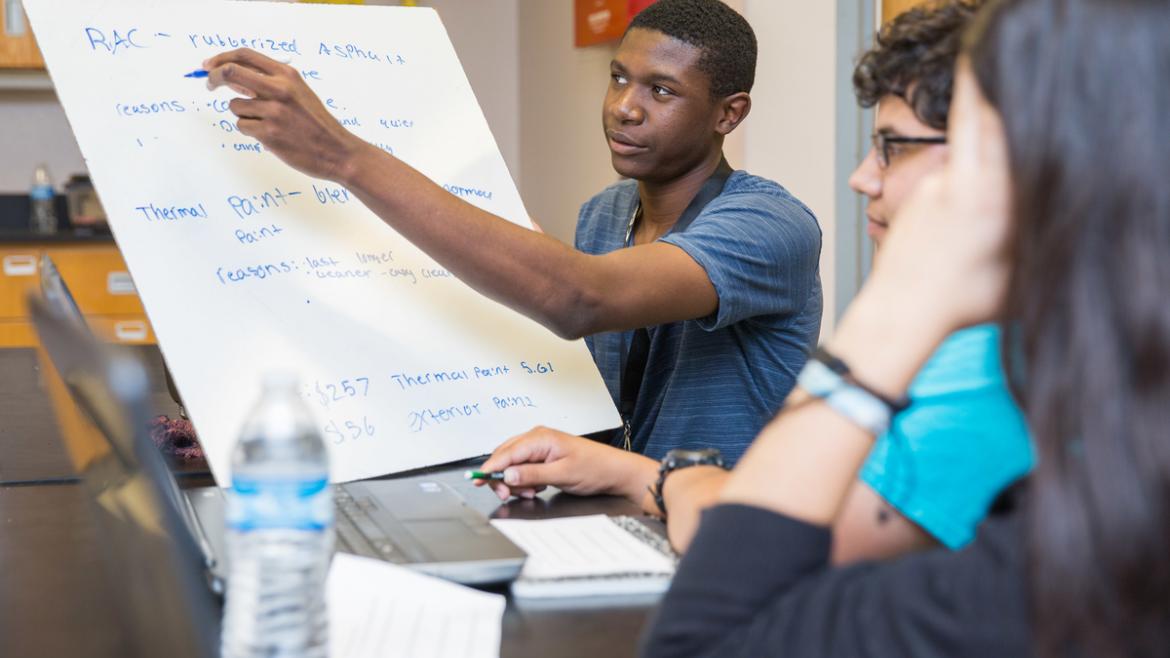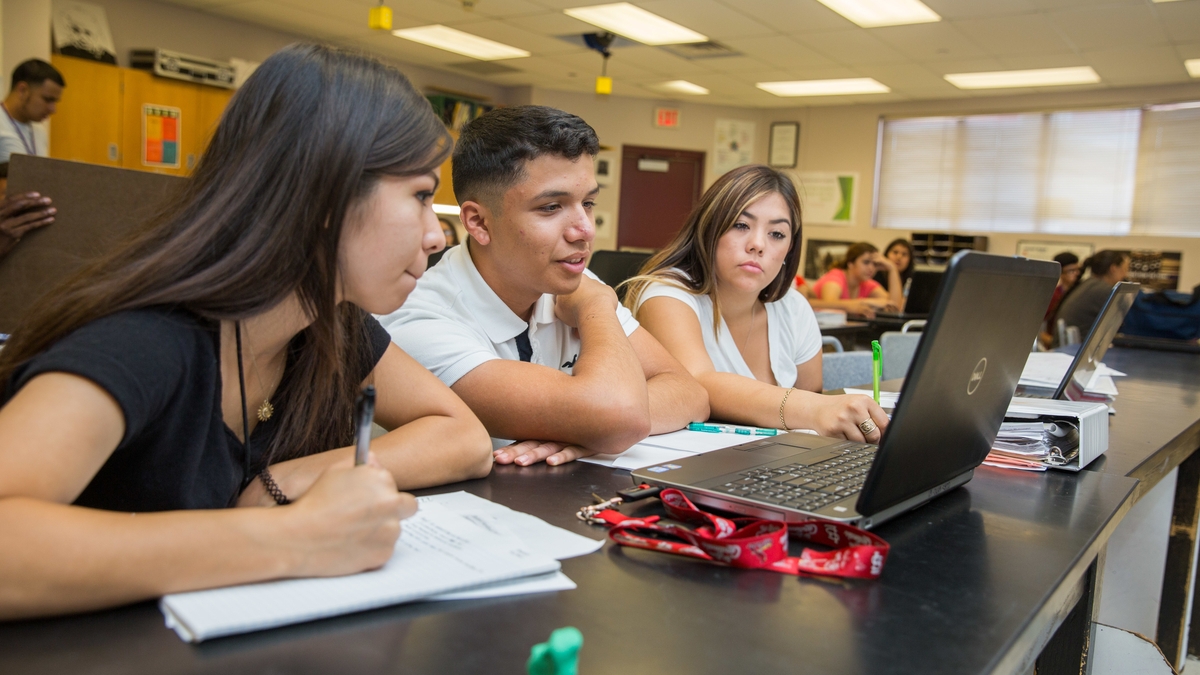Many freshmen come to college excited to learn about their majors — but sometimes less enthusiastic about all the first-year courses they’re required to take.
That’s one of the reasons why Arizona State University is trying an innovative model that could transform the way college students take classes by combining three courses and allowing them to produce real work.
The method, called ProModProMod stands for “project-based modular learning.", is being piloted by a few hundred students this semester. It streamlines the curriculum by combining general-education courses with classes in the students’ majors. There are fewer lectures and more teamwork. At the end of the year, the students have a tangible product — such as an artwork or a treatment plan.
“I think one thing that hurts the kids is a lack of coherence in the curriculum,” said Elizabeth Capaldi Phillips, professor of psychology in the College of Liberal Arts and Sciences.
“Thirty percent of ‘introduction to bio’ is the same as ‘introduction to psych.’ That’s not fair and it’s not sensible because you should be building on knowledge.”
Capaldi PhillipsCapaldi Phillips is also provost emerita, a University Professor and co-director of the Obesity Solutions Initiative at ASU., who is on the team that’s leading the ProMod initiative, said, “Project-based learning is one way of making things coherent, engaging the students and getting them to see the connections and care about what they’re learning.”
While project-based learning in a course is not new to ASU, combining courses and asking students to solve a problem is a reinvention. For example, kinesiology students take Kinesiology 101, Psychology 101 and English 101 in their module, in which they are developing an evidence-based treatment plan for lower-back pain. They learn about anatomy and treatment in the kinesiology part, how to get patients to comply in the psychology portion, and how to write concisely and coherently about their work in the English part.

ProMod students
Joshua Bowser and fellow students work on their heat-island reduction project in the ProMod program at Cesar Chavez High School. Photo by Deanna Dent/ASU Now
ASU has already overcome a major logistical problem with ProMod. Although the students take three courses together in a module, the classes are still graded separately on their transcripts.
“The registrar was a genius on that,” Capaldi Phillips said. “They’ll still get grades because if they want to go to medical school, they want to see grades.”
More than 300 students in 14 ASU programs are participating in the modules, taught by faculty teams, and the goal is for their entire degree to be project-based.
Along the way, they will learn skills that employers are demanding: writing, presentation, problem-solving and the all-important understanding of collaboration.
The students can see the connections in their classwork and appreciate that the required general-education courses are not a waste of time and money.
“I was excited about this because they wanted to make a change and it puts meaning into the course,” said Itzel Martinez Mejia, a freshman who is taking the ProMod in the School of Film, Dance and Theatre.
ProMod was started this fall, and it’s too early to know whether it will increase retention rates — or show other measurable results, such as better grades.
But so far, the new way of teaching and learning has invigorated both the students and the professors who are trying it.
“Sometimes we get bogged down with our students,” said Tannah BromanBroman is the kinesiology degree coordinator., a principal lecturer in Exercise Science and Health Promotion who is teaching a ProMod group this semester. “We think they’re not doing anything, they’re not doing well on the tests, they’re not engaged.
“This renews your faith in their ability to solve problems.”
ProMod provides a unique educational experience. Video by Ken Fagan/ASU Now
Students shape ProMod
ProMod is driven by students, not faculty.
Students design how they want to tackle the project. They divide the work. They learn the course material when it’s relevant to their project.
About 40 freshmen are participating in the School of Film, Dance and Theatre's ProMod, called “The Art of the Long Now.” They are exploring how different media can imagine a new future for the human race.
At the end of the fall semester, the students will have created a video project that encourages college students to think about the future. Their end-of-the-year project will be a media and performance installation.
“I’m really interested in the idea that students can have an impact on the world around them directly in that freshman experience, not waiting until they’re older or being in rehearsal while in college — but having an impact right then,” said Jacob PinholsterPinholster also is an associate professor of performance design., director of the School of Film, Dance and Theatre, who is teaching the module.
That opportunity is what drew Martinez Mejia to choose the ProMod program.
“The reason I want to be an actor is so I can have my voice heard and make an impact on the world, and the moment I heard about this program, I thought it was exactly what I wanted to do,” she said.
The camaraderie has enriched the experience.
“I thought we were going to do one whole idea, but every one of us has an individual idea and when we combine our ideas, it makes it so much bigger than what we thought,” said Martinez Mejia, who is from Avondale, Arizona.
“We’re like a family instead of a hundred people in one room.”
The “soft skills” the students will learn are critical to the ProMod concept.
“They’re going to learn how to react to difficulty and change because they’re going to run up against their own obstacles, or I will introduce artificial ones,” Pinholster said.
“They will learn the idea of being responsible to another person, to listen, to understand the value of what another person says and how to measure it against your own ideas and make an objective call.
“They’ll learn to not be precious about the things they’ve created but to put them out there and take a risk.”
Broman said she has been surprised at who is succeeding in her kinesiology module.
“Sometimes the ‘A’ students are the hardest ones to get on board. … Sometimes they suffer because there isn’t always a right answer or a single answer.
“You’ll have the ‘B’ or ‘C’ students pulling the ‘A’ students along, saying ‘Let’s just try this.’ ”
It starts in high school
ASU developed ProMod after receiving a $4 million “First in the World” grant from the U.S. Department of Education in 2014, the largest grant among the 24 institutions who were awarded. The competition, launched that year by President Barack Obama, was intended to find new ways to increase retention for students who are at higher risk of not completing their degrees — such as first-generation college-goers and teenagers from low-income families.
Of the 305 students who opted into ProMod this semester, nearly two-thirds receive the Pell Grant awards for low-income students. About 21 percent of the students are Hispanic.
Students volunteer to be in the modules and can opt out of continuing in the program.
The hands-on projects can level the playing field between students whose parents attended college and those whose parents are high school graduates who have no idea what university courses are like, according to Jeanne WilcoxWilcox is the principal investigator for the grant and is the Nadine Mathis Basha Professor of Early Childhood Education., a professor in the Mary Lou Fulton Teachers College who is on the ProMod team.
“I was very interested in the pipeline piece. We have a lot of kids who get to college and are not ready,” she said.
That’s another risk factor that leads to dropping out.
So ASU has partnered with Phoenix Union High School District to place ProMods into three high schools. Seniors at Cesar Chavez, Bioscience and Metrotech high schools take a module that combines English, communications, a science class and a sustainability class. If they matriculate at ASU next fall, they start with 13 credits earned from the ProMod.
Cesar Chavez has 21 studentsAll of the Cesar Chavez ProMod high school students are in the AVID program, which stands for Advancement Via Individual Determination and supports students who would be first-generation college students. in ProMod who were recruited because their transcripts qualified them for admittance to ASU.
Martin Irwin teaches the science part of the ProMod course at Cesar Chavez. His class is investigating ways to mitigate the effects of urban heat islandsUrban heat islands are cities that are warmer than rural areas because of heat absorbed by buildings and roads and from heat generated by energy use.. They’ve interviewed ASU experts and explored ideas such as reflective paint, rubberized concrete and vertically growing plant walls.
Irwin said the students stay more focused because they are together for four hours a day.
“The students truly enjoy what they’re doing, and it becomes more exciting to explore their ideas instead of coming up with my same ideas,” he said.
The students honed their writing skills by creating brochures to pitch their solutions, said English teacher Ben Pitts.
“English is there to support the science-driven questions. The English portion is taking what they learned in the research and communicating in a clear and concise manner,” he said.
Not all the students jumped at the chance to join the ProMod program, but were persuaded by Alesa Patterson, the AVID coordinator at Cesar Chavez.
“Any time you talk about college, the biggest concern for our students is paying for college,” Patterson said.
“When you talk about the opportunity to receive credit for free, they start to listen. And their parents start to listen. Besides which, the classes prepare you for any college. These are college-level classes.”
More Arts, humanities and education

ASU’s Humanities Institute announces 2024 book award winner
Arizona State University’s Humanities Institute (HI) has announced “The Long Land War: The Global Struggle for Occupancy Rights” (Yale University Press, 2022) by Jo Guldi as the 2024…

Retired admiral who spent decades in public service pursuing a degree in social work at ASU
Editor’s note: This story is part of coverage of ASU’s annual Salute to Service.Cari Thomas wore the uniform of the U.S. Coast Guard for 36 years, protecting and saving lives, serving on ships and…

Finding strength in tradition
Growing up in urban environments presents unique struggles for American Indian families. In these crowded and hectic spaces, cultural traditions can feel distant, and long-held community ties may be…
